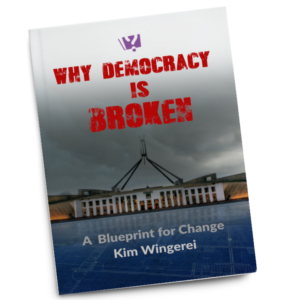Click play for Podcast.
Short term thinking has taken hold of our society at all levels – our political leaders rarely see beyond the next poll or the next election, and in many ways they are responding to a populace that is equally sucked into the demands of the moment – resulting in ‘the longevity vacuum’ – putting us all at the mercy of an unplanned future.
Ours is the age of impatience. It’s the age of instant gratification and quick fixes, the age of fast food and real-time messaging, overnight shipping, the twenty-four hour news cycle and the intimate immediacy of social media. We live in a world where ‘tomorrow’ is often too late and next year is too far away to contemplate.
Unfortunately, our politicians are no different. We think we elect representatives to plan for our collective future, but instead we get meek and pliable party delegates that react to yesterdays polls and whose horizon extend no further than the next election – never far away. Our executive government – regardless of its current political leanings – is equally mired in the minutiae of the day, poll driven and bereft of vision.
Gone are the days when Prime Minister Ben Chifley could push through the The Snowy River Scheme – a grand plan for irrigation and energy supply – against much opposition in 1949. As Chiefly said: “The Snowy Mountains Plan is the greatest single project in our history. It is a plan for the whole nation, belonging to no one state, nor to any group or section. This is a plan for the nation – and it needs the nation to back it”. Another politician with long term vision and tenure to match – Robert Menzies – cut the ribbon for the first stage in 1955, but the project was not completed until 1974. (For the record, Menzies was originally opposed to it.)
It is difficult to see how a project of that magnitude could be conceived in the age of impatience, let alone completed. Look no further than the muddle of poor planning, dysfunctional execution and endless cost overruns that is the Pacific Highway upgrade, now in it’s 22nd year and still years away from completion – subject to constant political meddling and infighting between the States and the Government about funding. And that’s just a four lane highway across flat land!
It is a testament to the longevity of the Snowy River scheme – and somewhat ironic – that Malcolm Turnbull’s flagship energy policy is ‘Snowy 2.0’, announced in 2017. In the scheme of things a rather modest upgrade – yet the projected costs have already doubled, before it has even started..
Snowy 2.0 is the current government’s answer (of sorts) to the absolute shambles that has been Australia’s energy policy. Or rather, the lack of a coherent policy. Others will have more to say about that, but suffice to say, in an industry where capital decisions are made with a purview of 20 to 30 years and beyond, with the effects of climate change hanging over us as the proverbial ‘Sword of Damocles’, our government has dithered. It has commissioned endless inquiries and reports that in the end they mostly ignore, under the auspices of a minister (Josh Frydenberg) so obviously out of his depth.
One of those reports was the ‘Finkel Report’ – a quite succinct and practical outline of how Australia can move towards clean energy by the year 2050. It is not my purpose here to discuss the merits of his recommendations, but I hold it up as an example of a report commissioned by the Government in recent years – others are the Henry report on taxation and the Gonsky report on education.
These are all strategic treatises that outline specific objectives based on coherent thinking on the long term effects of recommended policies. More often than not, these reports end up on the scrapheap of political expediency. Our politicians are no longer interested in, or capable of, addressing the issues of the day with long term solutions. Statements of vision disappear in the political oratory of vacuous grandiosity – motherhood statements like: a ‘fairer Australia’ and ‘nobody shall be left behind’, or my personal favourite: ‘securing the future for all Australians’.
At a time when so many of the issues we confront cry out for strategic thinking – environment, immigration and education to name a few – our politicians never seem to be able to see past the next election cycle. At the federal level that is a maximum of three years (six for senators) – and sometimes it ends up being a lot less than that when the governing party decides to call an election early. The big issues of our time (indeed of any time) call for planning decades ahead, not just a few years.
And not only do we elect our political representatives for very short periods, we then entrust some of them to become ministers in executive government. And we end up with an Energy Minister who is completely out of his depth on energy policy, a Health Minister who is a lawyer by trade and never run a hospital or a general practice, and an Education Minister who has hardly set foot in an educational institution since he left school. These ministers are supposed to be the ‘chairman of the board’ of the departments they are assigned to. Yet they typically only hang around for a single term at the most, before they are moved on to another portfolio for which they are often equally unqualified.
Granted, government departments are run by well qualified and competent bureaucrats. But whatever strategic advice they impart on their ministers are having to be reset after every election with a new minister coming on board. This ‘longevity vacuum’ is at the very heart of one of the fundamental problems with modern democracy: the glaring absence of long term plans and strategies.
Our short election cycles and having politically motivated ministers with election focused agendas is not working. There is a fundamental lack of long term strategic planning in government, a very costly absence of continuity and no discernible vision that engenders confidence in us voters that our future is in safe hands.
Quite the contrary. The longevity vacuum is one of the reasons why we, the people, have lost faith in our political leaders.





